Paris: 10 tips for riding the Metro like a local
Riding the Metro is a staple of everyday life for Parisians.
But the unwritten code of conduct isn’t something that comes instinctively to the more than 4 million people who hop on board every day. In fact, each year 1.5 billion riders use the Paris Metro — that’s almost on par with New York City!
Even if you’ve ridden the subway in Chicago or New York, it’s still worth brushing up on how Parisians commute and get around the city.
Related: Will a Navigo pass save you money on the Paris Metro?
10 Paris Metro tips for riding like a local
Ready to buy a ticket and jump on the Metro? Here are 10 tips to help you fit in like a local while you’re sitting (or standing) on the subway.
1. Buy tickets in bulk
I only use the Metro occasionally, opting for a bike, and thus use the money-saving Navigo Easy pass with t+, contactless bundles of 10 tickets sold at a reduced rate (€17.35, a nearly 20% savings on buying tickets individually). You can purchase the Navigo Easy pass at all stations or RATP-approved stores, then add more tickets either in person or on your smartphone.
Local tip: If you do have a monthly or weekly Navigo pass that you simply touch to the turnstile, be sure to keep it in the bottom of your bag and try to swipe your bag across the turnstile, ensuring that the people behind you will have to wait while you swipe four or five times before the magnetic reader catches your card. That’s the sign of a true local.
2. Know when to sit and when to stand
In general, if you’re sitting in one of the fold-up chairs and staring into a sea of crotches, it might be time to get up and make some room. During peak hours, those folding seats should be off-limits. Feel free to throw the stink eye at anyone who thinks otherwise.
Also, offering your seat to an older person or a child is always appreciated, but don’t get carried away with it. Sometimes, guys, offering your seat to a 30-year-old, fit-as-a-fiddle woman could seem insulting or just kind of awkward.
3. Show generosity to performers… in the station
Generosity is a virtue, but illegality is not. It is interdit (not allowed) to perform in Metro cars, and performers usually have a permit to perform uniquely in the stations themselves.
When a performer comes on board belting out an Edith Piaf song or pumping their accordion, giving them money is supporting an illegal activity, and that’s just not cool (even if they are phenomenal). Save your coins for the respectful players in the stations that sometimes produce some amazing music.
4. Take the stares
Make eye contact — often. This is the Paris Metro, where staring is a national sport. Be warned, however, that looking at someone a few too many times will be interpreted as a come-on of sorts, as it may be intended, so be sure to look for your description on a Craigslist “missed connections” later that evening.
5. Keep it down
Do us all a favor and keep the loud discussions down. Engaging in a loud conversation or telephone call is a surefire way to stand out from the crowd. During morning and evening commutes, you’ll be the only one with your phone glued to your ear or chit chatting away at full volume with your friend. Read a book, listen to some music, or play Angry Birds, but save the drawn-out conversations for the café.
6. Be pushy
While you may have to push your way onto the Metro at any hour during the day, it’s especially common during the morning and evening commute. When the doors open, the wall of people can seem daunting, but giving an angry “pardon!” and a little elbowing will help you get aboard.
Touching isn’t balked at, so don’t be afraid to use your hand and physically reposition someone if they won’t move. Locals know the drill. And once in the train, squashed in the crush of people, you’ll often notice quite a bit of vacant space that has gone neglected. Locals love standing near the door, apparently. Laws of diffusion rarely apply.
7. Eat, drink and be exiled
Parisians eat at tables, at food trucks, or begrudgingly in the streets. Those who eat in the Metro are shunned and eventually sent to Belgium, so don’t do it. Plus, with the bouquet of aromas wafting through the tunnels, it’s not really the most appetizing of eating environments.
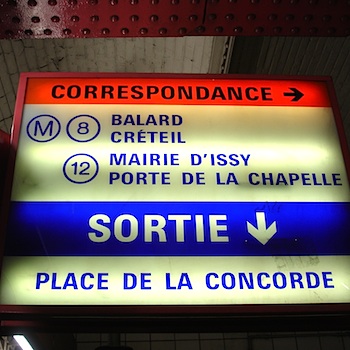
Know where you’re going before you get off!
8. Transfer strategically
Changing train lines once is acceptable, but annoying. Switching trains twice is sometimes necessary and really annoying. Switching three times is excessive and never required.
Know where you’re switching and where you’re going before you get off, to avoid that moment of lost panic that will signal to the pickpockets that you are, in fact, not a local. And avoid switching at the labyrinthine Chatelet-Les Halles for the love of all that is good.
9. All lines are not created equal
Locals have favorite Metro lines, but mostly they just hate certain lines. The 13 and the 4, both north-south lines, are among the most hated. Some revile the seemingly useless line 11, though it’s my personal favorite, catering to my needs. And taking the 1 is always like a trip to the UN, since it’s the most tourist-laden of them all. The 14 is a favorite because of its speed, and the 8 is often preferred to the more-crowded 9, since they generally go to the same areas.
So learn the lines using this Metro map, and be prepared to exhale frustrated and roll your eyes when someone says, “We have to take line 4!”
10. Love it
While the Paris Metro is far from perfect, it beats counterparts in New York and London by a landslide — at least this is what locals think. So when anyone disses the Metro because they have to wait six minutes for a train or because it smells like three-day-old urine, be proud and stick up for it, because love it or hate it, it’s the fastest and cheapest way to get you where you need to go in this town.
Your Paris Metro tips
Have a tip to add about the Paris Metro? Share your thoughts in the comments section below.
More information
For more on the Paris Metro, visit the website of the RATP, the government agency that runs the Metro. The website offers information in English for tourists. RATP also has a handy app that provides everything you need to get around. Additionally, you can now use contactless payment methods like credit cards or smartphone apps to pay for single journeys directly at the turnstiles. Finally, if you’re currently planning a trip to Paris, be sure to swing by our guide to Paris for more articles on ways to save, plus reviews of recommended budget accommodations.

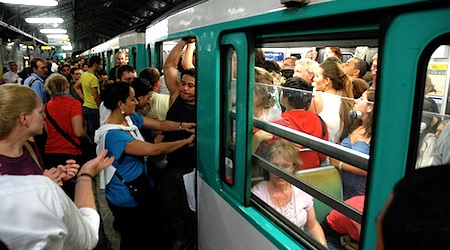

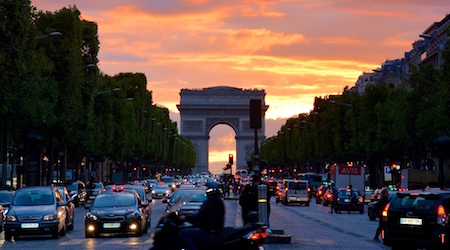
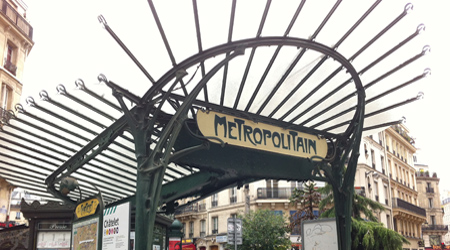

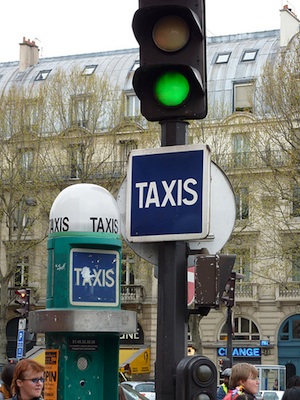

Bryan, that was a hilarious yet realistic telling of the metro! Loved it.
Many thanks for your good article about the Paris metro.
My favorite metro line in Paris is line which is (partly) elevated and it gives a new view on the Eiffel tower between the stations Passy and Bir-Hakeim.
Perhaps is our online navigation system for the Paris metro usefull too:
https://www.metrocazar.com/paris/
Line6 (sorry I didn’t mention the line number).
Excellent article Bryan! The comments are outstanding, too.
My first ride on the Metro, I got lost. It’s funny looking back on it, it wasn’t funny at the moment. But in figuring out how to get my bearings, I figured out how to use it efficiently and I think I can confidently ride it the next time I visit Paris.
KEEP YOU WALLETS IN AN INSIDE ZIPPERED POCKET!!!!!
comment to point 5: EVERYBODY hangs on the phone all the time. I never take out mine because I value the little time ‘off’ and read a book, do a sudoku, or let myself get borne to my destination with half-closed eyes. But I swear, when I see (very rarely) somebody else NOT on the phone, it’s like a gift and I throw a quick smile to the other ‘not connected’ person.
However: People really should be more watchful about their possessions. Last week alone I had to inform 2 German tourists that leaving their bag open , even holding them, is an invitation to be stolen and another one to turn their bag to their front and NOT play with their new phone. They were so obviously tourists that it hurt to see them.
All other points: Fully agree. Always, always beware of pickpockets. Do NOT bend over to pick up stuff; sad but true – what a world we live in!
Great post
comment to point 5: EVERYBODY hangs on the phone all the time. I never take out mine because I value the little time ‘off’ and read a book, do a sudoku, or let myself get borne to my destination with half-closed eyes. But I swear, when I see (very rarely) somebody else NOT on the phone, it’s like a gift and I throw a quick smile to the other ‘not connected’ person.
All other points: Fully agree.
Great post
Very nice article.
I wish there were a few sentences about pick-pockets and train ticket scams. My wife and I had just arrived in Paris and wanted to take a train. As we tried to figure out the ticket machine a pretty, well dressed, college age young lady approached us and offered help. She pushed the ticket buttons for us but our credit card seemed not to work. She asked if it was a French card and we said no. She used her card and we paid her cash. Of course, the card had a value far less than the cash we gave her. We knew better but were still in a travel fog. The ticket guy in the booth (where we should have bought the tickets in the first place) only could chuckle when he heard our story and checked our tickets for validity. Apparently, it is a common problem.
I like when the occasion presents itself to say ‘Good morning’ or ‘Good evening’ or ‘Good night’ to the station personnel one sometimes encounters, after all it is they who make it run!
I’m right now in Paris and I have to take the Metro daily. Of course I brought my “carnet de 10 tickets”. The Metro is efficient, but if you’re handicapped or a mother/father with a baby in a stroller, you are discriminated. No access, stairs up and down everywhere. I’m leaving in 3 days, but I am coming back soon.
Sadly, however, Paris is miles behind Munich and Hamburg for accessibility for travelers who can’t do stairs; in those cities elevators are everywhere. Even New York has more!
Pingback: Tips for taking the Paris Metro – #AzzyInFrance
It was about 11pm and I was returning to Charles de Gaulle-Etoiles after a concert at the now closed Salle Pleyel. I reached into my pocket to use one of my tickets which let me through the turnstyle without any problem. As I rounded the bend in the passageway I was confronted by five men and a woman, armed and wearing combat gear. I thought there must have been a bomb scare and I was being told I could not used the Metro, but no: these were the railway police demanding to see my ticket. I produced it and they told me it had expired and asked to see my passport. I explained that I did not understand what they were saying and there was no need to shout in my face in French. One of the men spoke English and told me that the police had been called and were on their way, but I could avoid arrest if i paid a fine in cash or with my credit card. Again, he demanded to see my passport. I said I did not have it with me, nor did I have a credit card and di not have enough cash (not true, of course). I called their bluff and said when the police arrived they could take me to the Australian embassy. This appeased them and the man wrote out a fine for 300 Euros. Of course I didn’t pay it. The moral of the story is stand your ground, don’t be intimidated and ask to be taken to your embassy. BTW I am a white woman in my 60s who always travels alone. Nonetheless, this shook me.
Just remember when you’re taking the RER train from CDG airport to central Paris – there aren’t many escalators and zero elevators at your destination, so pack light or take a cab.
Even better than buying a carnet is buying a “mobilis” all-day pass giving unlimited transportation. For 7 euros ride to your heart’s content. I even did a blog post on it: http://www.travelingprofessor.com/Home/tabid/56/ArticleID/49/ArtMID/471/Default.aspx
Steve
http://www.travelingprofessor.com
My wife is French so we go to Paris frequently and have for 40+ years. She even had the location of the changes in each station memorized so we would get on the car that would be the closest to the exit or the “correspondence.” We have never found the Visite Pass to be cost-effective. In former days, we got the Carte Orange and now use the Navigo. Since the weekly passes start on Sunday night and go to the following Sunday, the “carnet” of 10 tickets is useful depending on when you arrive in Paris. The monthly pass is an even better deal if you are there that long. Don’t forget the buses. We now use them much more than the Metro. Yes – they are slower but you get to see Paris moving by your window! I’ve become a master at reading the Bus Map for changes and can usually get us where we want to go with no more than one change. After 30+ years of using the Metro, I started to feel like a gopher – I would pop up at different parts of the City and only knew the areas around the stations – but not know how the City was connected together. With the bus, I know Paris much better. As with the Metro, the time of day is important to avoid the mobs. The tips in this article are “right-on.”
I have lived in Paris for three years, and I was just informed by a couple of natives that putting lipstick on in the Metro is akin to advertising that you are a hooker. Apparently, it is a very sexual gesture to put lipstick on anywhere in public. Who knew?
You might add that you should always stand to the side to let the passengers get off before getting on. Standing in the doorway is frowned upon. And I laughed at your remark about Chatelet. I call that stop Metro Hell!
Great post. I”m keeping this for a workshop I do on Paris!
V
A handy app is ParisbyMetro for changes, directions from here to there etc. you’ll never need to carry a map again and it doesn’t require wifi to work.
Thanks for lots of useful info Bryan
Carolg
If you use tickets and are not on the metro, you can use the same ticket to transfer within 90 minutes. So, for example, you can take the tram #3 from Porte d’Ivry, transfer to tram #2 at Porte de Versailles, then transfer at La Defense to any bus going to Colombe, as an example. However, you cannot do this from metro to bus. Also, if you have a monthly pass (Navigo) for zone 1 and 2, you can now use that pass to go anywhere, but only on the week-ends.
Randy
I liked the convenience of a Navigo Decouverte pass. If you arrive at CDG, it may be cost effective to get a zone 1-5 card, instead of a separate RER ticket. I arrived on a Tuesday, so it worked well for me. Would not be a good deal if you arrive on the weekend since the card is for a calendar week, not a 7 day period.
There is also a Paris Visite pass that is good for 1, 2, 3 or 5 consecutive days. Check it out to see it is a better deal for you.
KC
I was in Paris last year for the first time, and my wife and I each purchased 10 subway passes. After we passed through the turnstile, we would each discard our subway pass so that we did not get it mixed up with the unused passes. (This might sound dumb, but we live in the Midwest and do not use public transportation on a regular basis.) You can see where this is going.
One night, on our way out to dinner, as we were exiting the train and walking up the stairs to the street and there were police checking tickets. They asked to see a pass that was stamped within the last 60 minutes. I explained to the officer that we had thrown them away, but pulled out many unused tickets and asked if he could just take one of those. He told us we were lucky, because the fine is normally 75 Euros/person with no ticket, but since we had unused tickets to provide, the fine was only 35 Euros/each.
I explained to him that it was only our second day in France and was an honest mistake, but the officer told me that it is our obligation to understand the rules. I did not have cash on me, and he pulled out a credit card machine and swiped my card for 70 Euros.
So that one little train ride cost us 4 passes + 70 Euros!
I usually keep my unused tickets in one pocket and transfer the used ones to the other pocket. Of course, I need to remember to clean the “used” pocket out regularly.
Great article, Bryan.
The locals purchase a week-long pass called the Navigo Decouverte. It costs about 5 euros to get the picture ID card (a driver license size photo will do) and then about 21 euros or so for the week long pass Zones 1-3 that gives unlimited travel on metro, bus, intracity RER, and funicular (at Montmartre). However, it only goes from Monday-Sunday.
Very funny and oh-so-true. Except I never knew busking on metro cars is illegal. I love ligne 10!!
Another tip — if a train is too crowded and you’re not in a rush, it might just be wiser to wait for a less crowded train or head to a different car. This is especially true during rush hours.
I was once on a Metro car that was so crowded and hot that a woman fainted, but remained on her feet since she was pinned up against the other passengers.
Sometimes it’s worth it to wait out the crowds.
As visitors we found it essential to know the ‘direction’ (last station on the line) we were heading. It sounds obvious I know but you need to make quick decisions at times. Also, know which train track of a pair is going in the direction you need. I suppose trains keep Right, like cars, but it isn’t clear when you are feeling under pressure! We dragged cases up and down steps several times looking for info, but the platform we needed was just ‘over there’ on the other side. Thank heavens for the local who solved it for us!
Know that as the hours advance, pickpocketing increases. The “children pickpocket” segment has a quota to meet each day, and if they don’t lift enough cell phones, wallets, cameras, etc by the time the metro shuts down, they get slapped around by the parents when they return to their encampments outside the city. So watch out on line 1 and RER B and the night falls…these are their prime hunting grounds and they ratchet up their activity from 10PM onwards.
Great minds think alike, Bryan! Ashley and I finally posted to short video we made as a “How to Ride the Paris Metro” http://www.pret-a-voyager.com/2013/02/how-to-ride-the-paris-metro/
And beware the trio of teenage girls who seem to be endlessly running around catching trains haphazardly. I never know what those chicks are up to, but they look suspicious. They remind me of Whiskey Jack (birds) who work together to steal your stuff.
Let’s also add: if you are on a metro car that is very overcrowded (or the line 1 any time of the day or night, no matter how crowded) WATCH YOUR CELL PHONES, BAGS AND WALLETS. The pickpockets are everywhere and you can’t let your guard down. Even those of us who think we know better (ahem) have fallen victim (line 1, I’m looking at YOU).
A great post. Might I add an important item?
Beware of anyone who drops a cell phone. Don’t be inclined to help them pick it up. If you are standing, move to another part of the car. Why? This is a favorite ploy of pickpockets, who work in teams. I have a good friend who lost his wallet and a lot of cash this way.
I did, however, see a totally innocent person drop a cell phone. Within a matter of seconds, literally the time for him to bend over and pick it up, he was standing completely by himself, with people packed together at the ends of the car. Looking very embarrassed, he got off at the next stop.
@Christophe — that’s an excellent point to keep in mind (and a pretty funny story.) Never heard of the “drop the cellphone” scam before, good to know.
‘Drop the phone’ scam happened to me in Chicago, and gosh damn if it didn’t work like a charm…my wallet was swiped in one swift moment. Been on guard ever since.